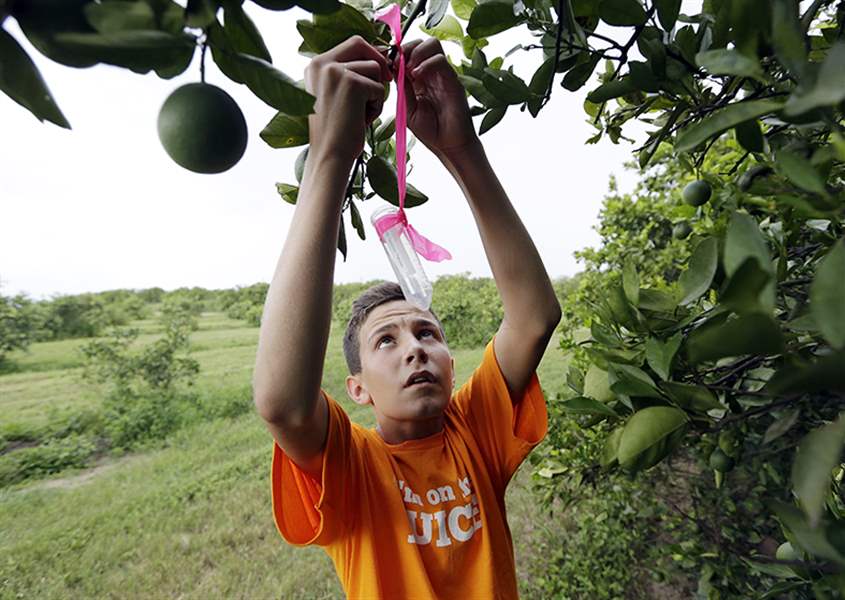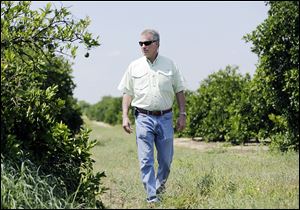
Invasive insect puts squeeze on Florida citrus
Growers work on cure for lethal disease that threatens $9 billion industry, state’s identity
8/31/2014
Nick Howell, 13, a member of the McLean family that owns Uncle Matt’s organic orange juice company, places a vial containing the tamarixia wasp to release in their orange groves to battle greening.
ASSOCIATED PRESS

Nick Howell, 13, a member of the McLean family that owns Uncle Matt’s organic orange juice company, places a vial containing the tamarixia wasp to release in their orange groves to battle greening.
LAKE WALES, Fla. — The tourists stream to Florida in their cars, intent on a week at Disney World or a sugar-sand seashore or a nonstop party on South Beach. Road weary and thirsty, they pull over at one of the state’s five official welcome centers. They walk inside, and then they look up.
“The best start under the sun,” reads a big sign. “FLORIDA ORANGE JUICE.”
Behind a counter, a woman sits with a stack of paper cups.
“Welcome to Florida,” she says. “Orange or grapefruit?”
The juice is cold and sweet. It tastes like the Sunshine State.
Once, emerald green trees bursting with citrus carpeted more than half of the state, from the northern reaches of Jacksonville and the parks of Orlando to the Miami coastline. Oranges, especially, have long been synonymous with the magic of Florida.
Think back to those ads touting orange juice as a vitamin-filled glass of goodness. The dream of Florida as a tropical vacation paradise was cemented in Americans’ minds through such promotions. Today, the orange adorns the state license plate. There is even a county called Citrus.
The people behind the groves have been among Florida’s most influential. The University of Florida’s famed football stadium was named after an orange magnate, and at least three of the state’s governors were citrus growers.
Throughout the decades, citrus has stood strong — through freezes, hurricanes, and rampant development. But now the $9 billion industry is facing its biggest threat yet, putting at risk the state’s economy but also its very identity. Blame a mottled brown bug no bigger than a pencil eraser that carries a lethal disease.
In China, where the problem was discovered, it’s called huanglongbing. Translation: “the yellow dragon disease.” In Florida, it’s known simply as “greening.”
It arrived here via an invasive bug called the Asian Citrus Psyllid, which carries bacteria left behind when the psyllid feeds on a citrus tree’s leaves. The tree continues to produce usable fruit, but eventually disease clogs the vascular system. Fruit falls, and the tree slowly dies.
The psyllid isn’t native to Florida, but it is believed to have arrived from someone who perhaps unknowingly brought a slip of a tree from Asia. Some think it then spread on the winds of hurricanes a decade ago. Greening has no cure, and no country has ever successfully eradicated it.
All of that has Florida’s growers in a frenzy to find a way to stop it.

Ellis Hunt Jr., 61, walks past an orange tree, left, affected by ‘greening’ in Lake Wales, Fla. He estimates he spending $2,000 an acre on production costs. Much of that, he says goes to try to control the psyllids. ‘It feels like you’re in a war,’ he says.
“It feels like you’re in a war,” said Ellis Hunt, Jr., whose family owns 5,000-plus acres of orange groves and is part of the co-op that contributes to Florida’s Natural, the third-largest juice brand in the country.
Mr. Hunt estimates he’s spending some $2,000 an acre on production costs, a 100 percent increase from 10 years ago. Much of that goes toward nutrients and spraying to try to control the psyllids.
The thought of the demise of his farm — of Florida citrus — gnaws at him.
“We can’t let this thing go down on our watch,” he said.
Nearly all of the state’s citrus groves are affected in varying degrees by greening disease, and researchers, growers, and experts agree that the crisis has begun to compromise Florida’s prominence as a citrus-growing region. Florida is second in the world, behind Brazil, in growing juice oranges, producing about 80 percent of the juice in the United States.
This last growing season, the state produced 104 million boxes of oranges, which comprise the bulk of Florida’s overall citrus crop. In 2003, two years before greening was discovered and prior to several devastating hurricanes, 243 million boxes were picked.
“This affects the whole state. The economic impact. The landscape. The iconic image of Florida and how it has drawn people here to smell the orange blossoms in the spring and look forward to that Christmas gift of fresh Florida citrus,” said state Agriculture Commissioner Adam Putnam, whose family has grown oranges since the early 1900s.
“It will have a ripple effect throughout the economy if we can’t get our arms around this disease,” he said.
Experts say that if a solution isn’t found, Florida’s entire citrus industry — with its 75,000 jobs — could collapse. Compounding the problem is the timing: The disease coincides with an increase in foreign competition and a decrease in juice consumption as health-conscious consumers count carbs. In July, U.S. orange juice retail sales fell to the lowest level in 12 years for a second straight four-week period.
California growers also are petrified of greening. The psyllid has been found in various sites in the state, and greening was found in one residential tree in Los Angeles in 2012. California scientists are doing their own experiments and piggybacking on the Florida research.
Concern is growing in Texas too, where a growers’ trade group said the disease had been found in 430 trees in commercial groves and 207 in residential backyards.
Arizona officials say the disease has not been spotted there.
In Florida, the war room in the fight against the yellow dragon is found in Lake Alfred, 30 miles southwest of Walt Disney World, in a cluster of buildings at the University of Florida’s Citrus Research and Education Center.
There, some of the world’s top citrus researchers — from the United States, China, Brazil, and India — slouch over microscopes and peer into makeshift greenhouses, hoping to unlock the greening puzzle.
The researchers are concentrating on two things: a short-term workaround that will allow existing trees to survive, and a long-term solution — possibly three to five years away — to develop a tree that is resistant to greening.
“A lot of people are looking for miracle cures,” said Jude Grosser, a horticulture professor who has spent his 30-year career developing citrus varieties and is now focused on solving greening. “But the answer for greening will be a number of different pieces. Our part is the genetic resistance to the disease.”
Experiments study everything from how fast the psyllid flies to how it’s attracted to the odor of an infected tree. Another study, under way at an organic grower’s groves, assesses whether the tiny tamarixia wasps can gobble the bad bugs.
Some growers are taking matters into their own hands. Rick Kress, president of Southern Gardens Citrus, has hired a private team of researchers to work on genetically engineering a greening-resistant tree with the DNA from spinach. He understands that introducing juice from a genetically modified orange would create another hurdle because of the public’s perception of such foods.
But the alternative — no juice at all — is unthinkable.
“Irrespective of the challenges,” Mr. Kress said, “Florida orange juice is not going to go away.”